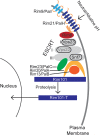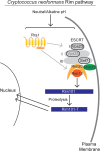The Cryptococcus neoformans alkaline response pathway: identification of a novel rim pathway activator
- PMID: 25859664
- PMCID: PMC4393102
- DOI: 10.1371/journal.pgen.1005159
The Cryptococcus neoformans alkaline response pathway: identification of a novel rim pathway activator
Abstract
The Rim101/PacC transcription factor acts in a fungal-specific signaling pathway responsible for sensing extracellular pH signals. First characterized in ascomycete fungi such as Aspergillus nidulans and Saccharomyces cerevisiae, the Rim/Pal pathway maintains conserved features among very distantly related fungi, where it coordinates cellular adaptation to alkaline pH signals and micronutrient deprivation. However, it also directs species-specific functions in fungal pathogens such as Cryptococcus neoformans, where it controls surface capsule expression. Moreover, disruption of the Rim pathway central transcription factor, Rim101, results in a strain that causes a hyper-inflammatory response in animal infection models. Using targeted gene deletions, we demonstrate that several genes encoding components of the classical Rim/Pal pathway are present in the C. neoformans genome. Many of these genes are in fact required for Rim101 activation, including members of the ESCRT complex (Vps23 and Snf7), ESCRT-interacting proteins (Rim20 and Rim23), and the predicted Rim13 protease. We demonstrate that in neutral/alkaline pH, Rim23 is recruited to punctate regions on the plasma membrane. This change in Rim23 localization requires upstream ESCRT complex components but does not require other Rim101 proteolysis components, such as Rim20 or Rim13. Using a forward genetics screen, we identified the RRA1 gene encoding a novel membrane protein that is also required for Rim101 protein activation and, like the ESCRT complex, is functionally upstream of Rim23-membrane localization. Homologs of RRA1 are present in other Cryptococcus species as well as other basidiomycetes, but closely related genes are not present in ascomycetes. These findings suggest that major branches of the fungal Kingdom developed different mechanisms to sense and respond to very elemental extracellular signals such as changing pH levels.
Conflict of interest statement
The authors have declared that no competing interests exist.
Figures









Similar articles
-
Malassezia responds to environmental pH signals through the conserved Rim/Pal pathway.mBio. 2024 Oct 16;15(10):e0206024. doi: 10.1128/mbio.02060-24. Epub 2024 Aug 27. mBio. 2024. PMID: 39189745 Free PMC article.
-
cis- and trans-acting localization determinants of pH response regulator Rim13 in Saccharomyces cerevisiae.Eukaryot Cell. 2012 Oct;11(10):1201-9. doi: 10.1128/EC.00158-12. Epub 2012 Aug 3. Eukaryot Cell. 2012. PMID: 22865500 Free PMC article.
-
Characterization of additional components of the environmental pH-sensing complex in the pathogenic fungus Cryptococcus neoformans.J Biol Chem. 2018 Jun 29;293(26):9995-10008. doi: 10.1074/jbc.RA118.002741. Epub 2018 May 16. J Biol Chem. 2018. PMID: 29769315 Free PMC article.
-
Liaison alcaline: Pals entice non-endosomal ESCRTs to the plasma membrane for pH signaling.Curr Opin Microbiol. 2014 Dec;22:49-59. doi: 10.1016/j.mib.2014.09.005. Curr Opin Microbiol. 2014. PMID: 25460796 Review.
-
Ambient pH gene regulation in fungi: making connections.Trends Microbiol. 2008 Jun;16(6):291-300. doi: 10.1016/j.tim.2008.03.006. Epub 2008 May 3. Trends Microbiol. 2008. PMID: 18457952 Review.
Cited by
-
Creeping yeast: a simple, cheap and robust protocol for the identification of mating type in Saccharomyces cerevisiae.FEMS Yeast Res. 2022 Apr 26;22(1):foac017. doi: 10.1093/femsyr/foac017. FEMS Yeast Res. 2022. PMID: 35298616 Free PMC article.
-
Interactions between copper homeostasis and the fungal cell wall affect copper stress resistance.PLoS Pathog. 2022 Jun 23;18(6):e1010195. doi: 10.1371/journal.ppat.1010195. eCollection 2022 Jun. PLoS Pathog. 2022. PMID: 35737716 Free PMC article.
-
Saturation transposon mutagenesis enables genome-wide identification of genes required for growth and fluconazole resistance in the human fungal pathogen Cryptococcus neoformans.bioRxiv [Preprint]. 2024 Aug 6:2024.07.28.605507. doi: 10.1101/2024.07.28.605507. bioRxiv. 2024. Update in: PLoS Biol. 2025 May 22;23(5):e3003184. doi: 10.1371/journal.pbio.3003184. PMID: 39131341 Free PMC article. Updated. Preprint.
-
Amino Acid Permeases and Virulence in Cryptococcus neoformans.PLoS One. 2016 Oct 3;11(10):e0163919. doi: 10.1371/journal.pone.0163919. eCollection 2016. PLoS One. 2016. PMID: 27695080 Free PMC article.
-
Calpain research for drug discovery: challenges and potential.Nat Rev Drug Discov. 2016 Dec;15(12):854-876. doi: 10.1038/nrd.2016.212. Epub 2016 Nov 11. Nat Rev Drug Discov. 2016. PMID: 27833121 Review.
References
-
- Bertuzzi M, Schrettl M, Alcazar-Fuoli L, Cairns TC, Muñoz A, Walker LA, et al. The pH-responsive PacC transcription factor of Aspergillus fumigatus governs epithelial entry and tissue invasion during pulmonary aspergillosis. PLoS Pathog. 2014. Oct 16;10(10):e1004413 10.1371/journal.ppat.1004413 - DOI - PMC - PubMed
-
- Huang W, Shang Y, Chen P, Gao Q, Wang C. MrpacC regulates sporulation, insect cuticle penetration and immune evasion in Metarhizium robertsii. Environ Microbiol. 2014 Mar 10; - PubMed
-
- Narayan S, Batta K, Colloby P, Tan CY. Cutaneous cryptococcus infection due to C. albidus associated with Sezary syndrome. Br J Dermatol. 2000;143(3):632–4. - PubMed
Publication types
MeSH terms
Substances
Grants and funding
LinkOut - more resources
Full Text Sources
Other Literature Sources
Molecular Biology Databases

